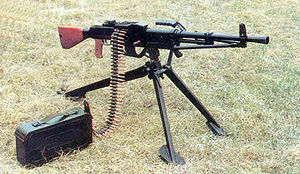| Type 67 | |
|---|---|
 The Type 67 on a tripod field mount | |
| Type | General-purpose machine gun |
| Place of origin | People's Republic of China |
| Service history | |
| In service | 1967–present |
| Used by | See Users |
| Wars |
Vietnam War Lebanese Civil War War in Afghanistan Syrian Civil War [1] Yemeni Civil War [2] [1] |
| Production history | |
| Designer | Dr. Duo Ying Jian |
| Designed | 1959 |
| Manufacturer | China North Industries Corporation |
| Produced | 1967– |
| Variants | Type 67-1, Type 67-2 |
| Specifications | |
| Mass | 11 kg (24.25 lb) |
| Length | 1,650 mm (65.0 in) |
| Barrel length | 605 mm (23.8 in) |
| Cartridge | 7.62×54mmR |
| Action | Gas-operated, tilting breechblock |
| Rate of fire | 650–700 rounds/min |
| Effective firing range | 800–1000 m |
| Feed system | 100/250-round belt |
| Sights | Rear leaf sight, forward post |
The Type 67 is a general-purpose machine gun, chambered in 7.62×54mmR formerly used by the People's Liberation Army. [3]
History
The Type 67 machine gun was developed as a lightweight replacement for the Type 53 ( SG43) and Type 57 ( SGM) medium 7.62 mm machine guns in 1959. [4] The first tests for the Type 67 started in 1963. [4] Research on the weapon was led by Dr. Duo Ying Jian from the Beijing Industrial Technology Academy. [5] After Soviet-Chinese relations began to break down, there were concerns that further technological assistance would not be rendered, including supplying them with Soviet-made PKMs. [5]
The first combat use of the Type 67 was with Mujahideen forces fighting in Afghanistan fighting against pro-Soviet forces in 1980. [4] These found their way through smuggling in Pakistani soil. [4] In the Syrian Civil War, the Type 67 is found in use with Syrian opposition forces fighting against government forces from 2015. [3] It is suggested these were likely captured from Syrian troops. [3] It has also been used in the Yemeni Civil War against the Houthis. [3]
Design history
According to a United States Army Materiel Command analysis, the Type 67 uses the DP trigger mechanism, the quick-change barrel of the SG-43, a gas regulator similar to the RPD, the ZB vz. 30 bolt mechanism, and a modified Maxim-type feed mechanism. [6]
The furniture was made in wood with the integral non-detachable bipod attached to a gas tube. [7] For using the Type 67 at long range, a tripod can be used when needed. [7] The Type 67 was initially supposed to be used as a medium machine gun (exclusively with a tripod), but Chinese engineers studied a captured M60 GPMG from American-led military forces in the Vietnam War. [5] Further design revisions were made where the bipod was made standard to be used. [5]
Since 1967, the Type 67 has gone through two model modifications and improvements, with the newer models designated Type 67-1 and Type 67-2. [1]
Variants
- Type 67-1: This has a non-fluted barrel with the bipod clamped to the barrel below the front. This can be removed. [7] Furniture is made from plastic. [7]
- Type 67-2: Uses the same barrel, but lighter. [7] Tripod is used instead of a bipod, made from stamped steel instead of steel tubing. [7] The gunner can attach a telescopic or night sight. [7] On late production models, the AA sight base is removed. [7]
Users
This section needs additional citations for
verification. (October 2023) |
 Bangladesh
[1]
Bangladesh
[1] Cambodia
[8]
Cambodia
[8] Central African Republic
[9]
Central African Republic
[9] Equatorial Guinea
[9]
Equatorial Guinea
[9] North Korea
[1]
North Korea
[1] Palestine:
Palestine Liberation Organization[
citation needed]
Palestine:
Palestine Liberation Organization[
citation needed] Syria: Used by the
SAA and by
Free Syrian Army
[1]
Syria: Used by the
SAA and by
Free Syrian Army
[1] Tanzania
[10]
Tanzania
[10] Yemen
[1]
Yemen
[1]
Former
Non-state actors
References
- ^ a b c d e f g h Ferguson, Jonathan; Jenzen-Jones, N.R. (17 March 2016). "Chinese Type 67 GPMGs in Syria & Yemen". armamentresearch.com.
- ^ "Chinese Type 67 GPMGS in Syria and Yemen – Small Arms Defense Journal".
- ^ a b c d "Chinese Type 67 GPMGS in Syria & Yemen - Armament Research Services (ARES)". 17 March 2016.
- ^ a b c d "Type 67 GPMG". 10 November 2010.
- ^ a b c d "中国67式7.62毫米通用机枪_Type 67 7.62mm General Purpose Machinegun_GlobalMil-环球防务网".
- ^ Small Arms Identification and Operation Guide—Eurasian Communist Countries Archived 2016-03-04 at the Wayback Machine, Defense Intelligence Agency/ United States Army Materiel Command ST-HB-07-03-74, p. 264
- ^ a b c d e f g h "Indigenous Machine Guns of China – Small Arms Defense Journal".
- ^ ទាហានខ្មែរ ដោះនិងរៀបដាក់កាំភ្លេីង PKMS K57 K67 | Army Institute Cambodia on YouTube
- ^ a b Touchard, Laurent (17 December 2013). "Centrafrique : le Soudan a-t-il armé les ex-Séléka ?". Jeune Afrique (in French).
- ^ "Google Sites".
- ^ James H. Willbanks (2004). Machine Guns: An Illustrated History of Their Impact. ABC-CLIO. p. 134. ISBN 978-1-85109-480-6.
- ^ "WEAPONS OF THE ISLAMIC STATE | Conflict Armament Research". www.conflictarm.com. p. 17. Retrieved 2020-12-22.